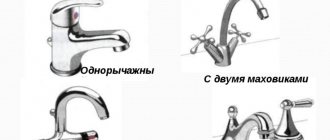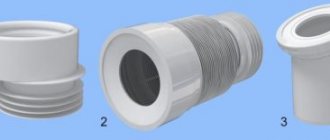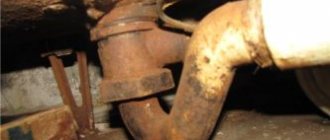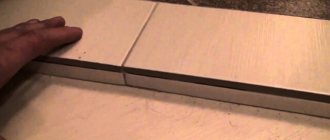Diagnosis of the problem
The reason for the hum in the pipes is turbulence of the flow, which appeared due to a leak in the connections of the plumbing elements. Leaks that occur in shut-off valves change the cross-sectional area of free passage inside the pipe space. This is how vortices appear that hum.
Air leaks due to leaks cause a series of hydraulic shocks, which cause vibration of the pipes. It often accompanies annoying sounds similar to a honking train.
Water pressure
To check the pressure in the pipe, it is necessary to carry out a certain procedure. To do this, you need to open the tap completely and let the water flow a little. After this, the water should be turned off; if the hum does not stop, it means that the pressure in the water supply exceeds the norm. The following relationship can be derived: the higher the pressure in the pipes, the brighter and faster the hum will appear. In order to eliminate this problem, it is necessary to install a special air chamber in front of the tap. The main purpose of such an addition is to absorb sudden pressure changes in the pipe.
Diagram of the air chamber to the tap.
To install such a camera, you can use two methods:
- special auxiliary section of pipe of the required diameter;
- a muffler that will eliminate sound during the passage of water.
Such devices are manufactured in industrial conditions. They are equipped with a built-in chamber that will suppress significant surges in water pressure in the pipeline.
If vibrations of pipes and excessive humming of the screen occur in case of loose installation, additional compaction must be done using available means. You can do such work yourself, but if you are not confident in your own abilities, it is better to seek help from specialists. Once these seals and fixations of the pipeline are completed, the vibration and hum should stop.
Main causes of noise
All of these symptoms of “disease” in your home water supply system appear due to faulty plumbing. The reasons for buzzing and leaks are identical for all cases. As a rule, these are water quality and wear of sealing elements. I would like to dwell on the reasons why the faucet hums in more detail.
Why do the pipes hum when you turn on the tap?
The water supply valve is designed in such a way that the cross-section for the free passage of liquid through it is blocked by a valve with a seal at the connection point. The gaskets are made of elastic rubber to prevent leakage.
Nothing lasts forever in nature, and gaskets periodically fail. They are pressed through the metal body of the valve. Under the influence of time, rubber becomes rougher, loses elasticity, and the tightness is broken.
As a result, a loose gasket no longer holds the liquid pressure. The flow entering under pressure enters a leak and turbulence occurs, which is accompanied by an unpleasant whistle or causes the faucet to hum. Don't be alarmed, it's easy and cheap to repair.
It also hums if cold water is forced under pressure into the hot water supply pipeline. This happens when the hot water boiler is stopped for repairs or due to the departure of the owners and, out of forgetfulness, they forget to close the shut-off valve that shuts off the boiler. Cold water in the mixer enters the DHW pipeline. The valve begins to hum due to vibration.
Calcium dissolved in tap water forms limescale deposits. They accumulate on the walls and create unevenness in the internal cross-sectional area of the pipe. This could be another reason for humming pipes.
Why does the toilet tank make noise when filling with water?
The noise in the toilet after using the toilet is familiar to all readers. This is the sound we get used to. But the hum of the tank is quite noisy and wakes up the inhabitants of the home if one of the family members had to get up at night.
There is an option with bottom supply, in which case the water does not hum. The loud sound is annoying if you have a toilet with a top water supply to the tank. This problem can be easily fixed using a rubber tube approximately 30 centimeters long.
The tube is pulled onto the supply fitting. Its other end lies at the bottom. Water from the fitting passes freely through the tube, spreads throughout the tank without hitting the bottom and practically does not buzz.
Shower hose leaking
Why is the bathroom faucet humming? One of the common reasons for this phenomenon is the presence of leaks in the hose that connects to the shower head.
To fix the problem, first of all, you should check whether all the same gaskets are damaged. If this is the reason, they need to be replaced.
Sometimes unpleasant sounds when turning on the water in the shower are caused by a rupture of the hose itself, namely its internal rubber tube, which is located in the middle of the metal sleeve. To deal with the problem, you need to seal the gap with a patch. However, for those who do not want to burden themselves with unnecessary work, it is best, of course, to buy and install a new hose.
Ways to solve the problem
Guaranteeing the good condition of the water supply system is a competent hydraulic calculation. Only on its basis can you correctly determine the diameter and material of pipes for communications.
The most radical solution to the problem that causes the system to hum loudly is to replace all old pipes and devices, including taps, with new ones in your apartment. But it is not a fact that it will bring results if the pipeline in the entrance or house is also faulty. It is necessary to determine where exactly the reason why the pipes are humming is located. Often these are valves and mixers.
DIY valve repair or replacement
Valve valve design features often become a source of problems. The use of ball valves instead of valve-type shut-off valves eliminates the need for frequent maintenance and replacement of gaskets. In new buildings, ball valves are immediately installed, and there the buzzing is much less frequent.
They are simpler and more efficient, although if they fail, they are practically beyond repair. This is not significant, because the cost of ball valves for apartment water supply is small. But if you still have a valve at home at the water inlet to the system, then repairing it yourself is cheaper than replacing it.
To do this, you need to block the access of water to the riser (if the house is multi-apartment). Try to unscrew the valve axle (sometimes called axle box). If the thread is stuck, it will not be easy to unscrew it. In this case, the valve body is heated with a gas burner, the axlebox is unscrewed and repaired.
Inside the apartment, locking devices operate on a similar principle, with only a slight difference. There are faucets in the bathroom and kitchen that we interact with every day. They fail more often than shut-off devices on the external pipeline. By design, they come with a rubber or ceramic seal.
- Crane axle box with rubber
To repair the mixer, you need to find out which part, when turned on, is the reason for the loud hum in the apartment. There are two options - this part is located either on a cold pipeline or on a hot one. Further:
- Shut off the water supply to the mixer.
- Unscrew the failed valve axle.
- Inspect the condition of the rubber and the seat in the mixer body.
- Replace the gasket on the valve.
- Screw the valve axle back into the housing.
- Check the tightness with a test water supply.
Some plumbers simply cut a bevel on the gasket at an angle of 45°, approximately 1 mm. Sometimes these simple actions are enough: the pipe no longer hums.
- Crane axle box with ceramics
If the faucet axle boxes of your mixer have a ceramic seal, then the cause of the noise may be a sagging silicone washer that compresses the ceramic structural elements together. In this case:
- Shut off the water supply.
- Unscrew the valve axle.
- Inspect the condition of the silicone seal.
- If the washer subsides, cover its surface with plastic.
- Screw the valve axle into the housing.
- Check the tightness by running a test run of water.
Repairing ceramic crane axle boxes is an ineffective measure. If a part fails, it is better to replace it immediately.
Poor quality installation of system elements
Why does the faucet hum several times a day? This can be caused by mistakes made by plumbers when installing structural elements of the water supply system or repairing them. If unpleasant sounds occur behind the wall, it is possible that the plumbers who serviced the neighbors’ system did not connect the pipes tightly enough or poorly insulated them. To determine exactly why the faucet is humming, you should first go down to the basement and check whether the water supply elements are tightly secured here. Once you are sure that everything is in order, you should contact your neighbors and together identify pipes that are not properly fixed. By eliminating installation defects throughout the riser, you can forget about the problem forever.
Other faucet malfunctions
The quality of modern faucets depends on the manufacturer and the materials from which they are made. As a rule, there are cheap models with a short service life. They say about these “put it in and throw it away”; an unsuccessful purchase begins to hum and leak after three months. But even high-quality and expensive faucets develop malfunctions over time.
Leaking from under the nut
Often, when installing a faucet axle box, in case of insufficient or excessive tightening of the threaded connection, the tightness of the rubber seal is broken and a leak occurs. To fix this problem, you can dismantle the part and replace the rubber band.
You can also wrap several layers of special elastic tape around the thread before screwing it into the body. It is inexpensive and sold at any plumbing store. However, this problem is not the reason that the system is humming.
The lever is leaking
The single-lever faucet design has gained popularity. It is easy to use and looks beautiful in the interior. The device of this type is not much more complicated than a traditional mixer. With it, the pipe practically does not hum, and it is easier to find out the cause of the malfunction. The main working element in such a mixer is the cartridge. If you see a water leak under the lever, then that is where the problem lies.
Use a screwdriver to remove the lever; to do this, unscrew the fixing screw that secures the cartridge and lever together. The clamping nut is unscrewed, the cartridge is replaced and reassembled in the reverse order. The mixer is ready for use again. Cartridges of any type are sold in plumbing stores.
Shower switch leaking
A bathroom faucet differs from a kitchen faucet in that it provides the ability to switch the direction of water flow. With the help of a switch we use the shower or wash our hands in the sink. But it is this switch that is sometimes the cause of the malfunction. Depending on the type, switches are:
- Spool valves.
- Push-button.
- Cork type.
All types usually have one common cause of failure - seals. What to do? The solution to this problem is to replace the worn sealing product. As before, you need to turn off the water supply, remove the switch and change the gasket. Nothing complicated.
Mixer valve leaking
There is a leak through the faucet housing of the mixer. This means that it has already served its purpose and requires replacement. It makes no sense to try to eliminate such a malfunction by violating the integrity of the part. Just buy a new crane axle box and replace the faulty one.
Shower hose leaking
The shower hose is located in the shell of the metal hose. The most common cause of hose leakage is a leaky diffuser. In this case, you need to tighten the connecting nut more tightly. If water flows from a metal hose, most likely the hose has burst due to poor-quality material and low elasticity of the tube inside the hose.
You can fix this yourself by using a fitting, onto which the ends of the tube are stretched at the rupture site. Then they must be pressed to the fitting with clamps. The video shows how this is done.
This review provided a brief analysis of problematic situations with plumbing in your home. I hope it was helpful. As you can see, there is nothing super complicated in the world of faucets and toilets. Knowing the design features, it is easy to cope with minor repairs on your own. Just change the gasket and the pipe will stop humming. The main thing is not to be scared or afraid. Believe in your strength!
(
3 ratings, average: 4.67 out of 5)
When it leaks from under the nut
Very often, leakage occurs due to a loose nut. Therefore, first you should try to tighten the nut more tightly. If this doesn't fix the problem, it's most likely a gasket issue.
If water continues to leak, you should first dismantle and disassemble the product. Most often, the problem is a rupture in the seal. The key needs to be replaced.
To work you will need an adjustable wrench.
- Unscrew the nut.
- Remove the old key from the gander.
- Replace the old gasket with a new product.
- Wrap two layers of tape around the thread.
- Insert the gooseneck into place and tighten the nut.
Why is the valve type tap knocking?
Two-valve faucet models are still widespread. If a hot water faucet of this type makes noise, then the cause is a malfunction of the axlebox faucet. Valve structures have separate axle-box taps for cold and hot water, on which ceramic or rubber gaskets are installed. It is the mechanical wear of these gaskets that causes noise and rattling.
To repair a valve mixer, you need to find out which gasket is in the axle box. Technically, it looks like this: you turn the valve and count the revolutions. If less than one is needed, then the faucet is equipped with an axle box with a ceramic gasket. And if more than two turns are needed, use a rubber one. Then everything is easy and simple, if you need to replace the rubber gasket. Replacing the ceramic gasket is a more troublesome task, since you will have to tinker with the silicone insert under the gasket.
Conclusion
An unpleasant loud sound when opening a tap in the bathroom or kitchen is a “bell” that there is a problem in the water supply system of the apartment or house that requires elimination. The situation should not be brought to the point where it is necessary to take emergency measures.
All you have to do is use our recommendations, which will help you quickly solve the problem yourself. The video in this article will give you the opportunity to find additional information on the above topic.
Did you like the article? Subscribe to our Yandex.Zen channel











